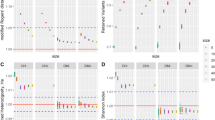Abstract
A study was made using the data obtained during a 1973 expedition to collect wheat in Sicily in order to determine possible sampling strategies for collecting genetic resource material. Based on these analyses tables have been developed for selecting optimum sample sizes depending on relative cost and variance component considerations.
It is almost impossible to make a general recommendation for optimum sampling strategy. Variation may be (andprobably is) different in diverse areas, thus what is true in Sicily may not be true for Ethiopia, etc. Also sampling strategy should be different for characters which are inherited quantitatively from those which are controlled by one or two genes. Visual selection will reduce quantitative genetic variation and thus will defeat the primary purpose of collecting geneticresource material, which is to preserve as much genetic variation as possible. On the other hand, all collectors intuitively collect forms which seem new or unusual to them. Certainly when collecting for specific characters, such as disease resistance, dwarf growth type, stem strength, etc., collectors will not resort to random sampling. Many of the traits are rare and only large samples will ensure that genes responsible for these traits will be represented in the collection.
Similar content being viewed by others
Literature Cited
Allard, R. W. 1970. Population structure and sampling methods.In Genetic Resources in Plants. Their exploration and conservation. O. H. Frankel and E. Bennett, eds. IBP Handbook No. 11, pp. 97–107. Blackwell, Oxford and Edinburgh.
Bennett, E. 1970. Tactics of plant exploration.In Genetic Resources in Plants. Their exploration and conservation. O. H. Frankel and E. Bennett, eds. IBP Handbook No. 11, pp. 157–179. Blackwell, Oxford and Edinburgh.
Cochran, W. G. 1963. Sampling Techniques. 2nd edit. John Wiley, New York.
Gevers, H. O. 1976. Unpublished Ph.D. dissertation. Univ. Natal, Pietermaritzburg, Natal, Republic of South Africa.
Marshall, D. R., and H. D. Brown. 1975. Optimum sampling strategies in genetic conservation.In Plant Genetic Resources for Today and Tomorrow. O. H. Frankel and J. G. Hawkes, eds. IBP Vol. 2, pp. 53–80. Cambridge Univ. Press.
Porceddu, E., P. Perrino, and G. Olita. 1975. Preliminary information on an Ethiopian wheat germplasm collecting mission. Proc. Symp. Genetics and Breeding of Durum Wheat, Bari, Italy, 14–18 May, 1973. pp. 181–200.
Shannon, C. E., and W. Weaver. 1963. The Mathematical Theory of Communication. Univ. Illinois Press, Urbana.
Author information
Authors and Affiliations
Additional information
Scientific paper no. 5482, College of Agriculture Research Center, Washington State University.
Rights and permissions
About this article
Cite this article
Bogyo, T.P., Porceddu, E. & Perrino, P. Analysis of sampling strategies for collecting genetic material1. Econ Bot 34, 160–174 (1980). https://doi.org/10.1007/BF02858631
Received:
Accepted:
Issue Date:
DOI: https://doi.org/10.1007/BF02858631




